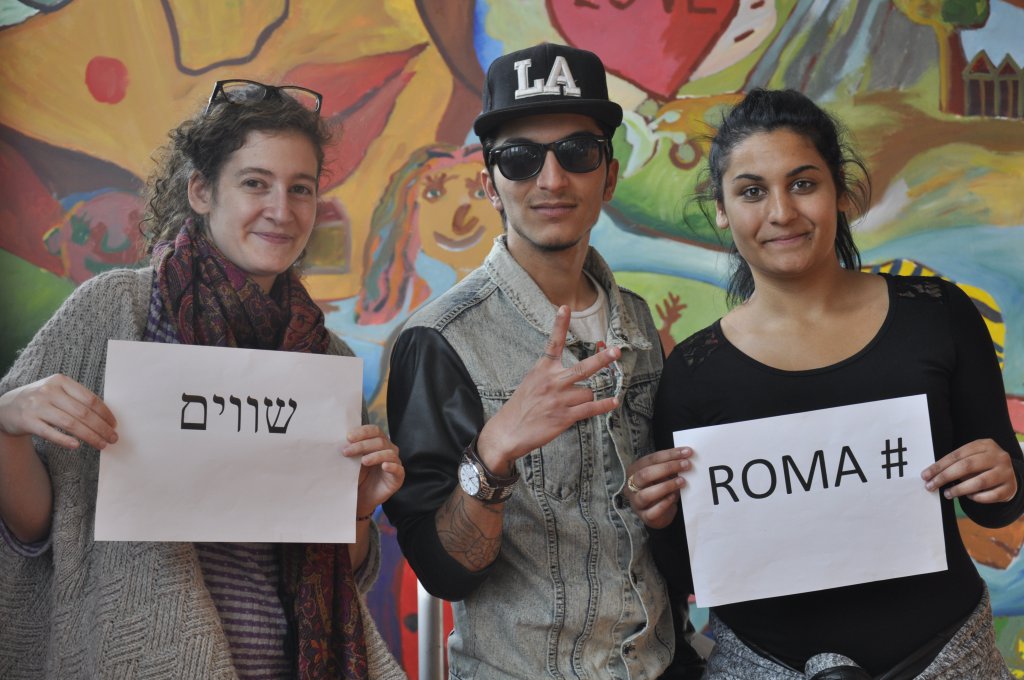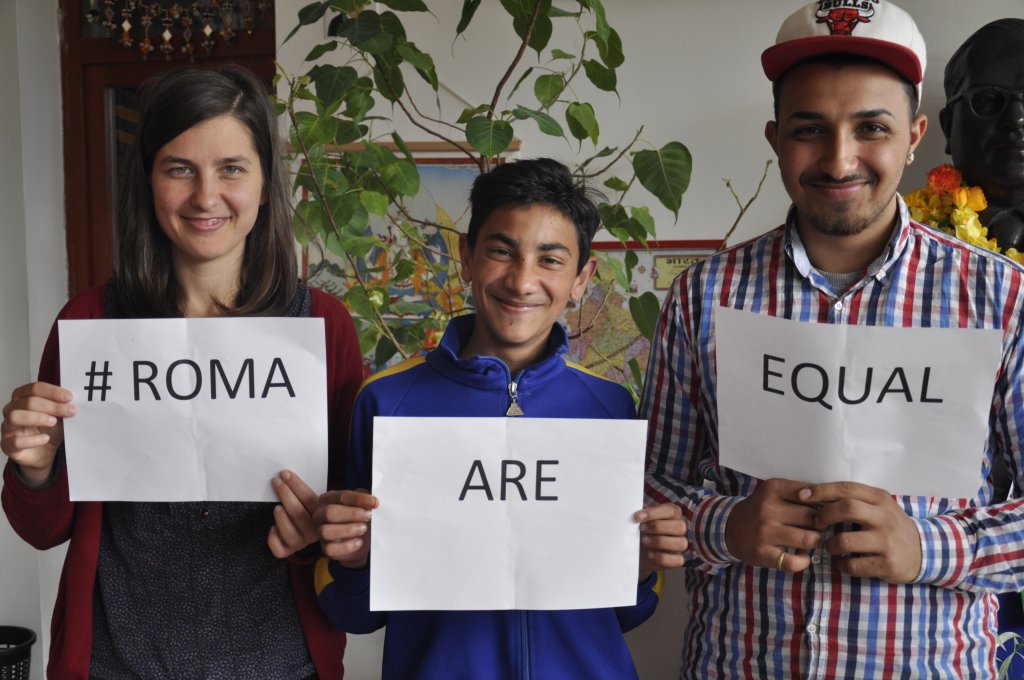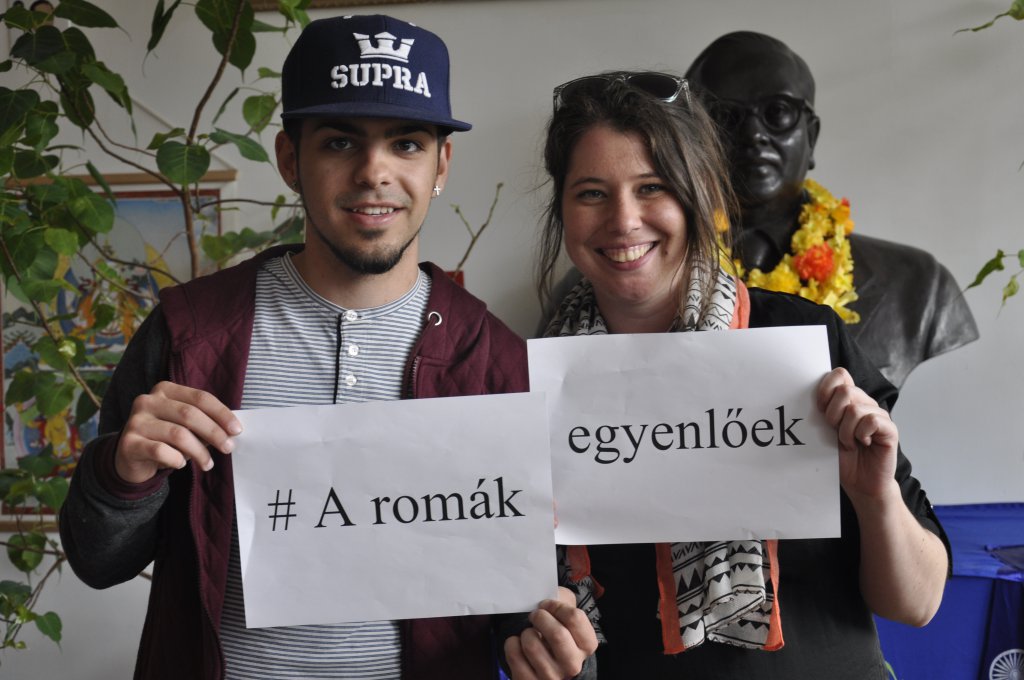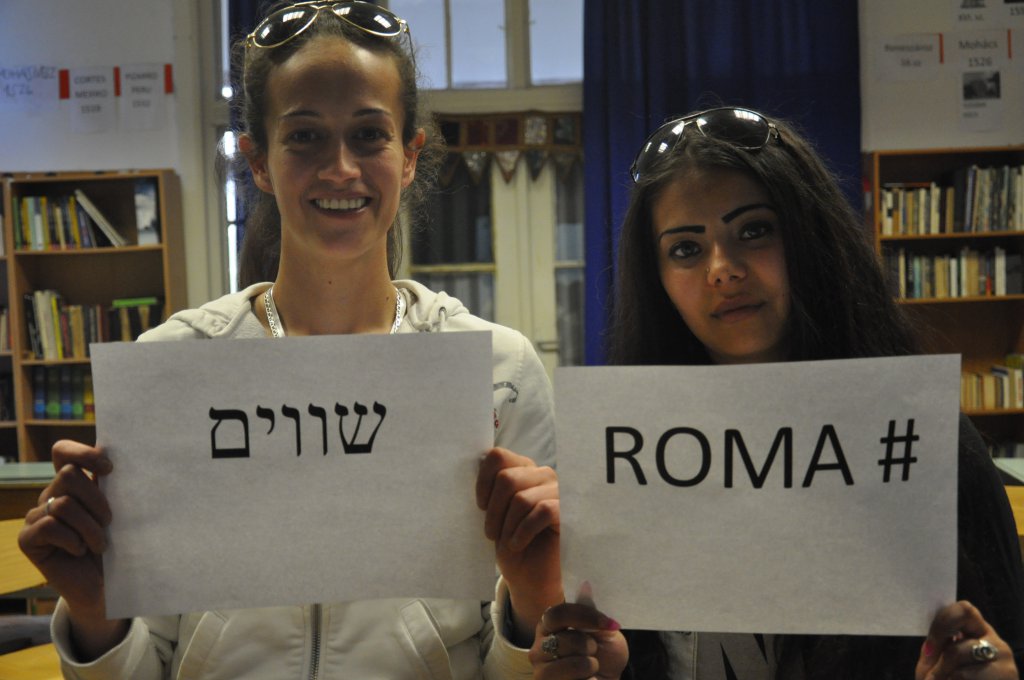MORE and the fruits of Roma-Jewish cooperation in Hungary
18 May 2016
All too often Hungary hits the headlines because of anti-Semitism and anti-Gypsyism. By way of a change here’s a good news story about grassroots Roma-Jewish cooperation.

Participants in JDC’s MORE Roma-Jewish Youth Leadership Training program showed their support for the #RomaAreEqual campaign at a recent group meeting at the Dr. Ámbédkar Iskola, the Buddhist high school in Sajókaza.
MORE (pronounced “mo-reh,” the name means teacher in Hebrew and person in Romanes, as in So keres more?) was jointly funded by the American Jewish Joint Distribution Committee (JDC/Joint), the Norway Grants/EEA Scheme, and the European Union of Jewish Students and ran for 20 months up to April 2016. MORE’s Jewish coordinators, working with Roma trainers provided young Roma drawn from Sajókaza and neighbouring villages with intensive training in leadership and youth organizing for 20 months.
As coordinator Anna-Sára Ligeti explained, “the program grew out of a Roma-Jewish summer camp we organized in 2013 with the Ámbédkar school which was very successful. Both teachers and students wanted to see more of this and we were serious about wanting to continue in a more complex way.” Towards this end they developed a frame for action, “we figured out the basics but it is the local community that tailors and adapts the methodology to meet local needs, and in this case it was the Roma students from the school. And now they have set up their local youth organization.”

“The program changed me!” said 17-year-old Evelin Jóni, “it’s a big deal that I can take care of smaller kids and organize programs for them. When I started these sessions I told the teacher I simply couldn’t manage such a thing, now I have the confidence to do just that.”
Similarly, her friend 18-year-old Benjamin Rontó said that he too gained much from MORE: “I wasn’t very good at holding conversations with people. This program helped me more than anything in building my self-confidence and my ability to express myself.”
Margit Varádi who lives in the tiny one-street village of Kano and travels 35 km daily to attend the school in Sajókaza, is studying for her final exams with one year to go. Like her peers, she relishes the responsibility of looking after the younger kids, and added “before this program I had no capacity to handle or manage conflicts. This is something very valuable that I learned here.”
Marianna Jó, manager of JDC’s international development initiatives in Hungary and project manager of MORE, said that following Tikkun Olam, which means to repair the world and has come to connote social action in pursuit of justice, JDC has long provided support to non-Jewish communities: “MORE is important precisely because there are very few programs targeting secondary school age Roma students at this fragile and very formative stage of their lives; and working with the Ámbédkar school, which spares no efforts in its drive to ensure students successfully complete secondary education, makes for the perfect partnership.”
Marianna who has worked for almost a decade on combating breast cancer in socially underserved communities has some insight into the social deprivation and discrimination faced by many of Hungary’s Roma. She explained that beyond the time span of the MORE project, “JDC is committed to remain partners with the Ámbédkar school and to support the newly established youth association. I’ve also formally joined this association.”
Coordinators Hanna Mikes and Sári Szilágyi described one important outcome of the program as the way students transform once they are given responsibilities, and how the experience of group organizing and working with younger children in turn affects their own behavior in a school setting. In addition to the learning outcomes for the young Roma, Sári explained that “MORE provided an opportunity for young Jews to meet their Roma peers. Where I grew up there were very few opportunities to meet with Roma. It wasn’t until I was 21 that I met some Roma, despite the fact that this is the biggest minority in Hungary. So this program also gave young Jews the chance to learn much about Roma culture.”

Hanna added that it was no accident that understanding identity was an important component of the MORE program: ”During the first 2013 Jewish-Roma camp, discussions about ‘what it means for you to be Roma’ revealed that for most of the young people it meant either nothing, was perceived as a negative identity, or simply the experience of discrimination.” As Anna-Sára put it, the MORE team of Jewish and Roma educators wanted to change this so that these young people could overcome the “negative self-image, low self esteem caused by stereotypes and exclusion” and positively affirm their Roma identity through the small community that formed around the project.
On the topic of identity, Benjamin recalled that before he came to the Ámbédkar school, he attended a school in neighbouring Kazincbarcika: “The school is a religious-run vocational school and they look down on the Roma. I couldn’t fit in there. There were two or three other Roma but they all left. It was strange for me, I grew up in a neighbourhood where there were no other Roma and before I went to school I didn’t even know I was Roma. I was confused about my own identity. Then I came to Sajókaza.
“When we learned through MORE about Jewishness it gave a new perspective to this ‘minority feeling’ – a good feeling and some security that we are not the only minority … I am absolutely sure that in a job this will be an issue. But I can live with this. I don’t mind because I am now proud to be Roma.” And Benji’s exploration of identity yielded a surprise, or as he put it, his “situation is a bit more complicated. I am not only Roma but I am also part Jewish. I just found out two weeks ago. I had become curious and began researching my family tree, and it turned out my mother is half-Jewish and my father is Roma. My mum wasn’t sure, because she was very small when both her parents died, so this was a real surprise!”
Sári remembered attending Jewish youth meetings when they were younger, and how they felt too shy to speak up, so she could relate to the youngsters’ lack of confidence at the beginning of the program. What made a difference for the success of the MORE project was the Sajókaza school “because most Roma kids don’t get the chances and support students get in the Ámbédkar school.” What has changed over the course of the program over 20 months of hard work, she says is that “the students who participated in the program have formed a community inside the school, and have organized recreation programs for the younger ones, and based on the feedback the students are confident and optimistic about future activities.”

As for the future, it is clear that the bonds formed will outlast the project period. Just like the other coordinators, Anna-Sára plans to join the youth association. She says, “I want to be in this association, in the background as a resource. When anyone needs any help, with grant proposals or administrative matters, I can come and help – but I wouldn’t want to be formulating what the association does. Basically, any help they need!”
Tibor Derdák, director of the Ámbédkar school reckoned that the MORE project managed in 20 months “to help us speed up a process that usually takes us six or seven years and often reaches far beyond the school setting. These girls and boys who are in the ninth and tenth grades have already become confident youth leaders, which is a huge thing, we would not have been able to get here so fast without this project.”




